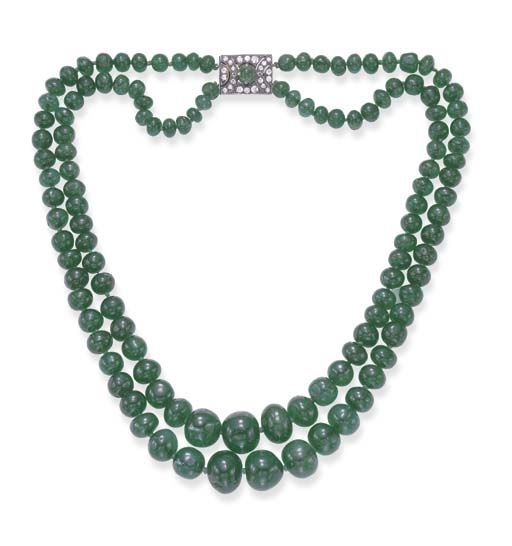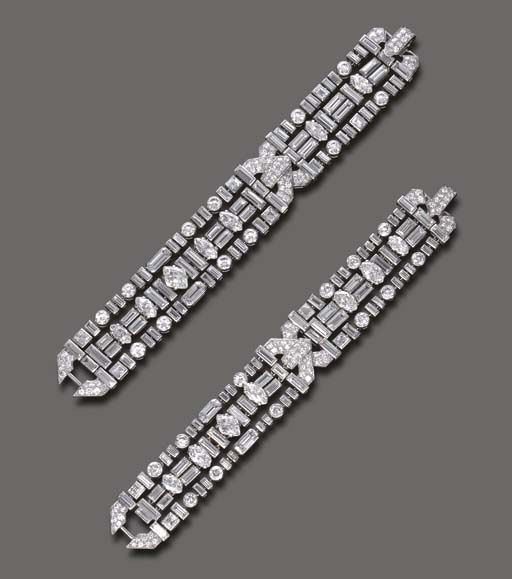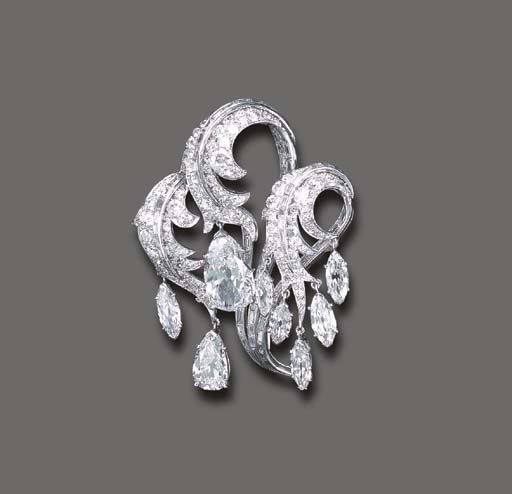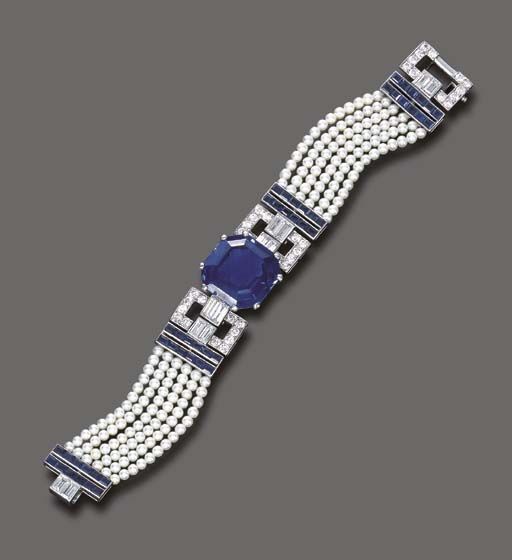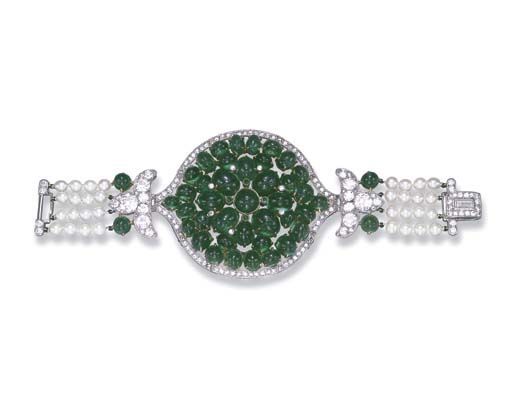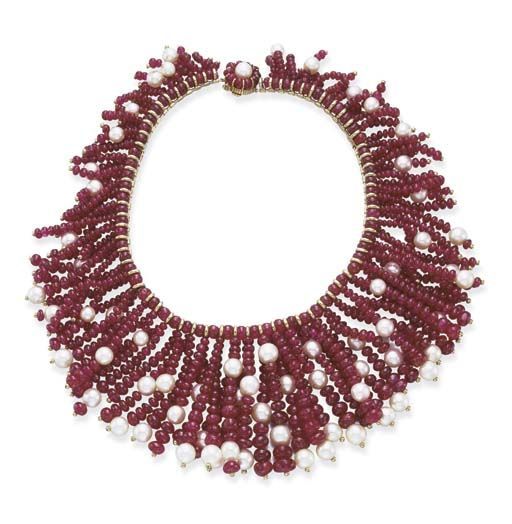![7a21dd2134ade19a83f638b401e844c6]()
The Doris Duke Collection of Important Jewelry. A magnificent Belle Epoque diamond and pearl pendant necklace, by Cartier. Photo Christie's Image Ltd 2004
The pear-shaped diamond pendant, within an openwork single-cut diamond frame, enhanced by three pear-shaped diamond tassel terminals, suspended by a pearl, measuring approximately 8.80 mm, from a similarly-designed cushion-cut diamond plaque, joined to the four-strand pear, marquise and French-cut diamond festoons, with single and old European-cut diamond trim and florets, further enhanced by an old European-cut diamond openwork clasp of geometric design, mounted in platinum, circa 1908. Estimate $800,000 - $1,200,000 - Price Realized $2,359,500
Provenance: James B. Duke; Cartier Paris, 24 December 1908, 18,500 Francs
Mr. Duke collaborated with Cartier in the creation of this necklace and supplied some of the larger diamonds. Originally designed as a sautoir, Cartier finally adapted the design to create this magnificent object.
Cartier and the Beautiful Era
Edward VII's ascension to the British throne upon the death of his mother, Queen Victoria, in 1901 marked the beginning of the Belle Epoque. Literally meaning 'beautiful era', it was a time when elegance was valued above all else in fashion and jewelry. The upper and middle classes flourished, especially in America, and indulged in clothing and jewels that expressed their wealth.
At the turn of the century, Cartier was establishing itself as one of the preeminent jewelers to the elites of Paris, London and New York. Their designs paralleled the fashions of the day: upswept hair and low necklines in the evening leant ever more importance to necklaces. Dog collars, sautoirs and lavalieres were popular styles, as was the garland style festoon necklace represented by this example. The garland, or neoclassical style incorporating ribbon, swag and bow motifs, was popular following the sale of the French Crown Jewels in 1887. The House of Cartier's innovations with platinum contributed to its ability to rework neoclassical designs in a newly light and flexible way. Although stronger than silver, which had been favored to display diamonds, platinum is less flexible, which prompted Cartier's designers to construct articulated jewels with hinged elements to create easy movement.
This necklace, lot 111, is a magnificent example of a Belle Epoque diamond, pearl and platinum garland necklace by Cartier. It ranks as one of the most important and beautiful necklaces representing this era, both for the luxurious elegance of the design and for the opulence of the diamonds. James B. Duke provided the firm with some of the diamonds employed. The original invoice from Cartier's Rue de la Paix boutique is dated 24 December 1908.
![32fa0536673ac7901e33b1989b8c742a]()
The Doris Duke Collection of Important Jewelry. An exquisite diamond ring, by Tiffany & Co. Photo Christie's Image Ltd 2004
Set with a rectangular-cut diamond, weighing approximately 19.72 carats, to the pavé-set diamond gallery and shoulders, mounted in platinum, circa 1935
Signed Tiffany & Co. Estimate $800,000 - $1,200,000 - Price Realized $1,261,900
With report 0402031 dated 9 February 2004 from the Gübelin Gemmological Laboratory stating that the diamond is D color, VS2 clarity; accompanied by a note stating that based on its infared spectrum, the 19.72 ct diamond described in Diamond Report No. 0402031 is classified as a type IIa
With report 13149214 dated 26 January 2004 from the Gemological Institute of America stating that the diamond is D color, VS1 clarity; accompanied by a working diagram stating the the clarity is potentially flawless
Provenance: Nanaline Duke, and by descent to Doris Duke
The King of Diamonds
The name Tiffany & Co. has long been associated with fine and important diamonds. The founder, Charles Louis Tiffany, was nicknamed the "King of Diamonds" during the late 1800s when his firm began purchasing fabulous diamonds from aristocratic European estates. Over the course of the past hundred years, Tiffany & Co. has cut, sold and collected some of the most magnificent stones in the world.
By the early 1840s, the American company had built up enough capital to enter the high-end gold and diamond jewelry market; but soon enough they became aware that their Parisian and London workshops could not meet their demand. Tiffany met this challenge by scouring all of Europe for diamonds. Eighteenth century diamond jewelry belonging to European aristocracy was an excellent source. The turbulence created by the French Revolution had increased supply, and hence the value of aristocratic jewels had dropped dramatically. Tiffany & Co. purchased important stones from renowned collections including the estate of the Hungarian Prince Esterhazy, from the noblest and richest family in Hungary; the "jewel-mad" Duke of Brunswick, including a 30 carat canary diamond; and the acquisition of the Spanish Crown Jewels. In 1887, the firm purchased a major share of the French Crown Jewels that had once belonged to Empress Eugenie. These magnificent jewels were brought back to America and soon adorned the newly wealthy industrial class. Perhaps the most remarkable of Tiffany's acquisitions was the purchase of a 287.42 cts. rough diamond from the Compagnie Francaise de Diamant du Cap Mine, a branch of the Kimberley mine, in 1877. It was cut in Paris to the current weight of 128.54 carats and named "The Tiffany Diamond". This was the largest flawless yellow diamond the world had ever seen.
The twentieth century witnessed a renewed interest in diamonds and the designers at Tiffany & Co. pioneered the trend. The firm continued to mount important gems into jewelry including the ring illustrated. This ring, dating from 1935, is a magnificent example of both Nanaline Duke's exquisite taste and the importance of Tiffany's diamonds. The 19.72 carat cushion-cut stone is elegantly mounted in platinum with delicate diamond-set shoulders. Typical of stones this size, the cushion-cut makes an understated and lovely outline. The cushion-cut is a transitional cut, linking the old mine with the old European. Most likely, Mrs. Duke's stone is of Golconda origin. This ledgendary Indian mine produced some of the most spectacular diamonds of the world including the Koh-I-noor, the Hope and the Agra which were all cut in the same cushion outline. According to Doris Duke's biography by Stephanie Mansfield, Mrs. Duke lost this diamond ring at a bridge party. Thankfully, it was returned to her.
![357b6066cb604916f8ca186caf2185bd]()
The Doris Duke Collection of Important Jewelry. A magnificent Art Deco diamond bracelet, by Cartier. Photo Christie's Image Ltd 2004
The openwork baguette-cut diamond geometric band, of flexible design, centering upon a marquise-cut diamond, weighing approximately 7.19 carats, flanked on either side by pear-shaped diamonds, weighing approximately 7.03, 6.24, 4.98 and 3.76 carats, joined by pavé-set diamond links and baguette-cut diamond arched spacers, mounted in platinum, circa 1927, 7 ins., in a Cartier red leather case. Signed Cartier, no. 2716752. Estimate $350,000 - $500,000 - Price Realized $1,217,100
With five reports dated from 29 January 2004 to 26 February 2004 from the Gemological Institute of America stating that the weight, color and clarity of the diamonds are as follows:
7.19 carats, F color, VS1 clarity; 7.03 carats, F color, I1 clarity; 6.24 carats, D color, VS1 clarity; 4.98 carats, G color, SI1 clarity; 3.76 carats, G color, SI2 clarity
Provenance: Nanaline Duke, and by descent to Doris Duke
![478d21cc99ddbb6da36e8822495a4ca7]()
The Doris Duke Collection of Important Jewelry. A magnificent two-strand emerald necklace. Photo Christie's Image Ltd 2004
Each strand composed of sixty or sixty-one graduated emerald beads, joined by a single and old European-cut diamond pierced plaque clasp, centering upon a cabochon emerald, mounted in gold and silver, circa 1935, 18¾ ins. The total weight of the emeralds is approximately 541.40 carats. Estimate $300,000 - $400,000 - Price Realized $1,127,500
![791cb079280c206ad243148c52ca7182]()
The Doris Duke Collection of Important Jewelry. A spectacular Indian diamond necklace. Photo Christie's Image Ltd 2004
The diamond collet line, suspending a fringe of twelve large foil-backed table-cut diamonds, each within circular-cut diamond frames with similarly-set foliate accents, the central table-cut diamond suspending an elaborate pendant of similar design, mounted in platinum, (many of the diamond drops are detachable), 15½ ins. Estimate $400,000 - $600,000 - Price Realized $701,900
Provenance: Madame Ganna Walska
Parke-Bernet Galleries, 1 April 1971, lots 80-82, $83,750
Literature: Stefano Papi and Alexandra Rhodes, "Famous Jewelry Collectors", Harry N. Abrams, Inc., New York, 1999, page 174-175
In the Parke-Bernet sale on 1 April 1971, Doris Duke purchased lot 80 for $7,250, lot 81 for $14,000 and lot 82 for $62,500. She likely combined the three lots (a pendant clip, earrings and necklace), to create the present necklace with a large central chandelier-style pendant. The sale that she purchased these lots from, "The Important Jewelry Collection of Madame Ganna Walska" was a single-owner sale of the flamboyant Polish soprano, Ganna Walska, (b. 1887). It is interesting to note that Walska apparently bought the necklace from Cartier in the early 1930s and altered it to her taste. When the necklace went up for auction in 1971, the necklace appeared quite different but with the same large foil-backed diamonds, each in the original circular-cut diamond borders.
![93963da64751a9909a4e4397e6640d1d]()
The Doris Duke Collection of Important Jewelry. An important pair of Art Deco diamond bracelets, by Cartier. Photo Christie's Image Ltd 2004
Each composed of three independent circular, navette, marquise and baguette-cut diamond lines, intersected by pavé-set diamond sculpted motifs, mounted in platinum, (may also be worn as a choker, 13¼ ins.), circa 1930, 6 5/8 and 7 ins. Signed Cartier, nos. 8410, 8354, 822 (2). Estimate 120,000 - $150,000 - Price Realized $433,100
![196061]()
The Doris Duke Collection of Important Jewelry. An elegant diamond clip brooch, by David Webb. Photo Christie's Image Ltd 2004
Designed as an undulating old European and baguette-cut diamond foliate scroll, suspending a central pear-shaped diamond, weighing approximately 9.67 carats, and a smaller pear-shaped diamond, weighing approximately 4.14 carats, further enhanced by a marquise-cut diamond fringe, mounted in platinum, circa 1957. Estimate 180,000 - $220,000 - Price Realized $343,500
With reports 8448680 and 13155477 dated 29 January and 2 February 2004 from the Gemological Institute of America stating that the diamonds weighing approximately 9.67 and 4.14 carats are D color, VS1 clarity and E color, VS2 clarity respectively
Provenance: Gift of James B. Duke to Nanaline Duke,
Gift to Doris Duke, December 1949
The diamonds used in this brooch originated from a diamond bracelet James B. Duke bought for his wife, Nanaline. In December 1949, she gave Doris the bracelet. Doris Duke then commissioned David Webb to create a spectacular brooch on 30 November 1957. Records indicate that Webb invoiced her for $3,000. A full list of the diamonds Webb used was provided on 9 January 1958.
![860827_view_04_03]()
The Doris Duke Collection of Important Jewelry. An elegant sapphire, diamond and seed pearl bracelet, by Cartier. Photo Christie's Image Ltd 2004
Centering upon a square-cut sapphire, weighing approximately 35.54 carats, flanked on either side by twin bagette-cut diamonds, circular-cut diamond rectangular links and calibré-cut sapphire spacers, joined to the six-strand seed pearl bracelet, enhanced by a clasp of similar design, mounted in platinum, circa 1925, 6½ ins. Signed Cartier, no. 24121. Estimate 100,000 - $120,000 - Price Realized $332,300
With report CS 36737 dated 22 January 2004 from the American Gemological Laboratory stating that based on available gemological information, it is the opinion of the Laboratory that the origin of this material would be classified as Ceylon (Sri Lanka). Heat Enhancement: None. Clarity Enhancement: None
James B. Duke commissioned Cartier to make this bracelet using stones he provided. The payment of $5,630 was not made until 8 November 1925, after his death.
![3379833f12e0f7ba2a16dbddf2df5c62]()
The Doris Duke Collection of Important Jewelry. An elegant Art Deco natural pearl and diamond bandeau, by Cartier. Photo Christie's Image Ltd 2004
The openwork old European-cut diamond tapering band, of geometric design, centering upon a pearl, measuring approximately 13.10 mm, enhanced by two pear-shaped diamonds, mounted in platinum, circa 1924. Signed Cartier, no. 2419203. Estimate 150,000 - $200,000 - Price Realized $3298,700
With report 13163096 dated 10 February 2004 from the Gemological Institute of America stating that the pearl is natural
The total weight of the natural pearl is approximately 12.77 carats
Provenance: Nanaline or James B. Duke; Cartier, 1 March 1924, $23,000,
and by descent to Doris Duke
Literature: Diana Scarisbrick, "Tiara", Chronicle Books, San Francisco, 2000, page 164-165
Exhibited: "Crowning Glories: Two Centuries of Tiaras", Boston, Museum of Fine Arts, Torf Gallery, 1 March-25 June 2000
Towards the turn of the last century, new styles of tiaras developed and increased in popularity. At the same time, a newly wealthy class of industrialists were becoming America's aristocracy and began to entertain with the same extravagance of European royalty. The charity ball and numerous private parties were new forms of socializing that gave stylish women an opportunity to wear tiaras outside of the traditional Court functions. The laurel wreath, acanthus and garland motifs were traditional types of tiaras, however, contemporary jewelers invented new styles to rejuvenate headpieces and jewelry. This tiara was purchased by either Nanaline or James B. Duke in 1924 and is an excellent example of the early Art Deco tiara. Designed to sit low on the forehead, rather than on the top of the head, this was the perfect look for the cropped boy's hairstyle favored at the time. The bandeau, with a geometric all-white diamond and platinum design, would have complimented perfectly the long sautoirs and straight and narrow silhouette.
![article_2378493_1AFD1D83000005DC_143_964x557]()
The Doris Duke Collection of Important Jewelry. An exquisite Art Deco emerald and diamond bracelet, by Cartier. Photo Christie's Image Ltd 2004
Of Indian design, centering upon a cabochon emerald plaque of circular outline, with single-cut diamond trim, flanked on either side by old European-cut diamond trefoil shoulders to the cabochon emerald and four-row cultured pearl bracelet, measuring approximately 4.50 mm, joined by a circular and rectangular-cut diamond clasp, mounted in platinum and gold, circa 1934, 6½ ins. Signed Cartier Paris New York, no. 2717519. Estimate 250,000 - $350,000 - Price Realized $209,100
Provenance: Cartier New York, 31 December 1934, $18,505 (as brooch)
This bracelet was originally purchased as a brooch from Cartier New York. On 11 January 1935, the diamond motif was mounted as a bracelet with pearls supplied by Doris Duke. She recieved a credit for the pearls and clasp.
Cartier's Indian Intrigue
The incorporation of Indian influences and gemstones into jewels was one of Cartier's greatest innovations in the Art Deco period. Jacques Cartier first grew enamored of Indian jewels at the turn of the 19th century. As the director of Cartier London, he was exposed to the lavish jewels of the Indian princes who often visited Britain. Jacques himself traveled to India in 1911 in an effort to establish Cartier's reputation among the Indian elite. Over time, he gained their admiration and respect, and the Indian elite entrusted Cartier to re-set and transform their jewels into modern designs, incorporating traditional motifs.
Indian tradition held that gems were a permanent investment. As they were passed from generation to generation, they would constantly be reset and jewels reinvented with old stones. Parisian styles and fashion fascinated the Indian elite of this time, so they were eager to have Cartier reinterpret their family treasures.
At the same time, as travel increased between the two continents, not only did Parisian styles grow in popularity in India, but Indian fashion and design became prevalent in Europe as well. Cartier began to purchase whatever precious gems were available in India, including delicately carved emeralds, sapphires and rubies. Many of these stones were incorporated into Cartier's Tutti Frutti jewels. Fine quality gems cut en cabochon were often used to reinterpret Mughal motifs from art of the Mughal Empire, which merged Hindu and Persian elements.
This bracelet, lot 107, incorporates three of the most valued gems in Indian jewels: emeralds, pearls and diamonds. The richly-saturated cabochon emeralds are the focal point of the bracelet, the bold, geometric plaque, trimmed by diamonds, extends diamond and emerald accents to the simple four-strand pearl bracelet and Art Deco diamond clasp. The bracelet is an excellent example of Cartier's interpretation of Mughal jewels. It is also interesting in the context of Doris Duke's collection as her purchase of the bracelet and clip in December 1934 preceded her first trip to India and the advent of her passion for collecting Mughal jewelry.
In February 1935, Doris Duke married James Cromwell, and the newlyweds spent most of the remainder of the year on their honeymoon in India. It was during this trip that Miss Duke was first captivated by Indian culture, especially the decorative and jeweled arts. The couple bought carpets, ivory carvings, tiles, jade, bronzes, clothing and jewels. Later, Doris collected Indian jewels in abundance, delighting in their heritage as much as in their decorative element. As with all of her jewels, Doris Duke exhibited refined taste in selection as well as the redesign of some pieces to her preference.
![b17139dad06d15c5f0dc2ae963776147]()
The Doris Duke Collection of Important Jewelry. An exquisite Art Deco diamond and enamel evening bag, by Cartier. Photo Christie's Image Ltd 2004
Of square outline, the black silk bag joined by a black enamel clasp, enhanced at either end by pierced pavé-set diamond plaques, to the central pave-set diamond pull of geometric motif, centering upon an old European-cut diamond, to the central baguette-cut diamond line, opening to reveal a white silk interior with a separate mirror, mounted in platinum, circa 1934, 6 3/8 x 5 7/8 x 5/8 ins. Signed Cartier. Estimate 20,000 - $30,000 - Price Realized $101,575
Provenance: Nanaline Duke, and by descent to Doris Duke
![ba7e05e39abbed6550209644891ada5a]()
The Doris Duke Collection of Important Jewelry. A spectacular ruby and cultured pearl necklace, by David Webb. Photo Christie's Image Ltd 2004
Designed as a multi-strand ruby bead fringe, accented by cultured pearls, measuring approximately 9.70 mm, to the ruby bead and polished gold neckchain and cultured pearl and ruby bead floret clasp, mounted in 18k gold, circa 1969, 16 ins., in a David Webb black suede case. Signed Webb for David Webb. Estimate 80,000 - $120,000 - Price Realized $93,210
Doris Duke commissioned this necklace from David Webb using three single-strands of pearls, 14 loose pearls and 1136 ruby beads she provided. The invoice for $4,000 was paid in full on 10 October 1969.
David Webb: The Quintessential American Jeweler
David Webb opened shop in the late 1940s in New York's jewelry district, but it wasn't until the early 1960s that Webb's popularity soared and he established himself as the quintessential American jeweler. He relocated to Fifty Seventh Street where he sold his designs to private clients in an upstairs salon, while maintaining relationships with Bonwit Teller and Bergdorf Goodman.
The 1960s were a period of change in American culture, as women gained greater independence and confidence; and David Webb captured that sentiment to create bold jewels that make a statement for the wearer. He was enamored of unusual gemstones, baroque pearls, and semi-precious stones, which he combined in modern and innovative designs. David Webb attracted a celebrity clientele. The Duchess of Windsor, Elizabeth Taylor and Jacqueline Kennedy visited his New York boutique and purchased his jewels and President Kennedy commissioned several gifts of State from him.
Doris Duke began to frequent David Webb's boutique in the early 1960s and often selected suites of jewels. She purchased dangling ear pendants, brightly colored necklaces and other bold pieces including lots 35, 36 and 38. It is not surprising that Doris Duke felt an affinity for David Webb's designs. Webb often used imagery from the Far East based on his studies of 18th century jewels from Jaipur, India. Doris Duke's life-long fascination with Indian jewelry and art began decades earlier and made Webb a natural choice for the commission of the Indian inspired fringe necklace, lot 79, and the emerald bead necklace, lot 84. Miss Duke actually supplied the cultured pearls, rubies and emeralds for the designs. Lot 94, the large cultured pearl and diamond ear pendants are also of obvious Indian inspiration.



































